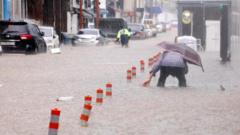South Korea is experiencing severe flooding due to heavy rains, with four recorded fatalities and more than 1,300 people evacuated. This extreme weather event has led authorities to raise the disaster alert to its highest level amid warnings of continuing severe weather.
As torrential rains continue to batter South Korea, the nation faces a devastating situation marked by four confirmed fatalities and over 1,300 evacuations. Authorities have elevated the weather-related disaster alert to its highest level amid ongoing forecasts of excessive rain. Among the deceased are two elderly men, one of whom perished while attempting to drain floodwaters from his home’s basement. Another victim lost his life when a wall collapsed onto his vehicle during the flooding, having previously informed his wife that his car was "being swept away." A fourth individual is reported to have died from cardiac arrest.
Residents in the affected areas, particularly in Seosan—the worst-hit city—are grappling with overwhelming water levels. One resident posted on social media, "Everything is covered by water except the roof of my house." Reports indicate that Seosan received over 400mm of rain in just half a day, resulting in what the weather agency has termed a once-in-a-century weather event.
Images circulating on social media depict homes and vehicles submerged, with furniture floating in the rising waters. Kim Ha-min, a Gwangju cafe owner, shared her experience of never having witnessed such extensive flooding, feeling frightened as floodwaters surged into her establishment. She stated, "I've never seen a flood here before, since there is no stream or river in this neighbourhood." After closing her cafe due to inundation, she expressed how the foul odor from the sewers made it impossible to reopen for business.
In addition to the fatalities, various injuries have been reported across the nation, including cases of hypothermia and leg injuries. As of Thursday afternoon, evacuations were ongoing, and authorities are urging individuals to steer clear of riverbanks, steep slopes, and underground areas due to heightened risks of landslides and flash floods. The meteorological administration indicates that the current deluge is a result of the convergence of dry air from the northwest and hot, humid air from the south. However, forecasts predict a return to high temperatures next week, raising concerns of a potential heatwave following the flooding crisis.
As torrential rains continue to batter South Korea, the nation faces a devastating situation marked by four confirmed fatalities and over 1,300 evacuations. Authorities have elevated the weather-related disaster alert to its highest level amid ongoing forecasts of excessive rain. Among the deceased are two elderly men, one of whom perished while attempting to drain floodwaters from his home’s basement. Another victim lost his life when a wall collapsed onto his vehicle during the flooding, having previously informed his wife that his car was "being swept away." A fourth individual is reported to have died from cardiac arrest.
Residents in the affected areas, particularly in Seosan—the worst-hit city—are grappling with overwhelming water levels. One resident posted on social media, "Everything is covered by water except the roof of my house." Reports indicate that Seosan received over 400mm of rain in just half a day, resulting in what the weather agency has termed a once-in-a-century weather event.
Images circulating on social media depict homes and vehicles submerged, with furniture floating in the rising waters. Kim Ha-min, a Gwangju cafe owner, shared her experience of never having witnessed such extensive flooding, feeling frightened as floodwaters surged into her establishment. She stated, "I've never seen a flood here before, since there is no stream or river in this neighbourhood." After closing her cafe due to inundation, she expressed how the foul odor from the sewers made it impossible to reopen for business.
In addition to the fatalities, various injuries have been reported across the nation, including cases of hypothermia and leg injuries. As of Thursday afternoon, evacuations were ongoing, and authorities are urging individuals to steer clear of riverbanks, steep slopes, and underground areas due to heightened risks of landslides and flash floods. The meteorological administration indicates that the current deluge is a result of the convergence of dry air from the northwest and hot, humid air from the south. However, forecasts predict a return to high temperatures next week, raising concerns of a potential heatwave following the flooding crisis.





















